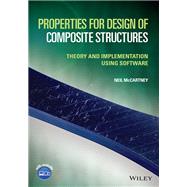A comprehensive guide to analytical methods and source code to predict the behavior of undamaged and damaged composite materials
In Properties for Design of Composite Structures: Theory and Implementation Using Software, distinguished researcher Dr. Neil McCartney delivers a unique and insightful approach to the development of predictive methods for the properties of undamaged and damaged laminated composite materials. The book focuses on presenting compact analytical formulae for several important effective properties—including mechanical, thermal, and electrical—that can be applied to a variety of reinforcement geometries.
The author introduces a compact notation that enables an explicit treatment of laminate property determination, including the out-of-plane shear properties required for three-dimensional numerical simulations of structural features using finite and boundary element analyses. There is also a detailed consideration of ply crack closure and a useful study of the interrelationships between the effective thermoelastic constants of damaged laminates.
The book also offers:
- A thorough introduction to the principles and formulae for homogenous materials and applications, including continuum and fracture concepts for homogeneous materials
- A comprehensive exploration of the properties of undamaged composites, including undamaged composite materials with multiple phases and the properties of a single undamaged lamina
- Practical discussions of the properties of damaged composites, including matrix cracking in UD composites and damaged laminates
- Consideration of effects of delamination, fatigue, and environmentally induced damage
- In-depth examinations of derivations of key results, including the analysis of bridged cracks and stress transfer mechanics for cross-ply and general symmetric laminates
Perfect for composite design engineers in all types of material-supplying industries and manufacturing companies, Properties for Design of Composite Structures: Theory and Implementation Using Software will also earn a place in the libraries of undergraduate and graduate students in engineering, aerospace, and materials departments.









